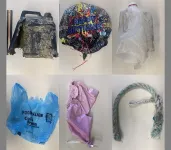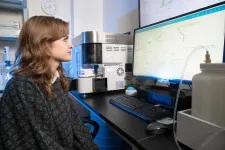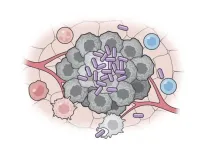(Press-News.org) BEAUFORT, N.C. -- To whales that hunt with soundwaves in the lightless depths of the ocean, a torn plastic party balloon and a delicious squid seem to be remarkably similar, according to a new study that put some plastic beach trash through underwater acoustic testing.
"These acoustic signatures are similar, and this might be a reason that these animals are driven to consume plastic instead of, or in addition to, their prey," said Duke University graduate student Greg Merrill, who led the research.
"One hundred percent of plastic marine debris tested have either similar or stronger acoustic target strengths compared with that of whale prey items," the authors report in a paper appearing online in Marine Pollution Bulletin.
To find food in the dark, deep-diving whales, like sperm whales, pygmy sperm whales and goose-beaked whales, send out clicks and buzzes from a vocal cord-like structure near their blowholes. These sounds are transmitted to the surrounding water by the bulbous oil-filled 'melon' structure above their mouths. Sounds that bounce back from objects in the water are received by fat-filled sensing organs in their lower jaws and sent to the inner ear and then the brain for interpretation. The system has been serving them well for at least 25 million years.
But ocean plastics such as shopping bags, ropes and bottles are a growing problem and are routinely found in the guts of stranded whales and other animals. Merrill wanted to test the acoustic signatures of the materials to see whether the whales were being confused by plastics.
After rounding up some typical, and barnacle-encrusted, plastic trash from beaches in Beaufort and nearby Atlantic Beach, N.C., the researchers put them under the sonar transponder on the Duke Marine Lab's ship R/V Shearwater to test them. "It was plastic bags, balloons, things that are commonly observed in the stomachs of stranded whales," Merrill said.
They made an H-shaped rig of fishing line with weights at the bottom to hold the samples four to five meters below the transponder, which is on the bottom of one of the catamaran ship's keels. Acoustic testing was then done at three different sonar frequencies, 38, 70 and 120 kilohertz, which spans the range of 'clicks' that different species of deep-diving whales employ.
For comparison, they also tested real (but dead) squid and pieces of squid beak that had been recovered from the stomach of a dead sperm whale.
The trash almost always sounded like food, especially plastic films and fragments of plastic, two particularly noisy items that are most often found in dead whales.
"There are hundreds of types of plastic, and the various material properties including polymer (chemical) composition, additives, shape, size, age/weathering, and degree of fouling likely play a role in the frequency-specific responses observed," the authors report.
Perhaps it would be possible to re-engineer some plastics to not have an acoustic signature, Merrill said. "But I don't think that's really a viable option, because then, if fishing net and fishing line are invisible, those are things that whales get entangled with, too. So we don't want them to not be able to identify those things."
Merrill worked on this project with scientists at neighboring marine labs operated by NOAA, NC State University and UNC – Chapel Hill.
CITATION: "Acoustic Signature of Marine Plastic Debris Mimics the Prey Items of Deep-Diving Cetaceans," Greg Merrill, ZT Swaim, IG Benaka, AL Bishop, NA Kaney, S Kuhlman, JC Matheson, E Menini, S Goh, S Lei, Doug Nowacek. Marine Pollution Bulletin, Dec. 2024. DOI: 10.1016/j.marpolbul.2024.117069
ONLINE - https://www.sciencedirect.com/science/article/pii/S0025326X24010464
END
Plastic pollution sounds just like food to deep-diving whales
Animals that hunt in the dark with sonar may not be able to tell junk from squids
2024-10-16
ELSE PRESS RELEASES FROM THIS DATE:
Innovating in the corners where atoms meet
2024-10-16
How can we engineer materials that are stronger and lighter? What about new materials for extreme conditions such as in jet engines and spacecrafts?
The answer, says Fadi Abdeljawad, an associate professor of materials science and engineering in Lehigh University's P.C. Rossin College of Engineering and Applied Science, might be hidden in the infinitesimally tiny regions, or boundaries, where atoms in crystals come together.
Along with his collaborators at the U.S. Department of Energy's Center for Integrated Nanotechnologies (CINT), Abdeljawad is uncovering how those ...
Study offers better insights into quality of life for adults with congenital heart disease
2024-10-16
Washington, D.C. (October 16, 2024) – For the first time, adults living with congenital heart disease (CHD) now have valuable insights into their long-term quality of life through data from the Congenital Heart Initiative (CHI). CHI is the nation’s first and largest patient-focused registry for adults with CHD and released its first study involving over 4,500 participants from all 50 states.
This research, published today in JAMA Network Open, marks a significant step forward in making better information available for the ...
Researchers offer alternative to hydroxyurea in study of DNA replication process
2024-10-16
Researchers at Colorado State University have identified an alternate method to study changes during the DNA replication process in lab settings using genetically modified yeast. The new approach offers a clearer window than current drug methods used to understand cell cycle arrest – a fundamental mechanism that is key to treating cancers and genetic issues.
The findings were published in the Proceedings of the National Academy of Sciences and were led at CSU by Assistant Professor Grant Schauer in the Department of Biochemistry and Molecular Biology. The work focuses on hydroxyurea, a chemotherapy drug used ...
New diamond bonding technique a breakthrough for quantum devices
2024-10-16
Synthetic diamond is durable, inert, rigid, thermally conductive and chemically well-behaved—an elite material for both quantum and conventional electronics. But there’s one problem. Diamond only likes diamond.
It’s homoepitaxial, meaning it only grows on other diamonds, and integrating diamond into quantum or conventional computers, quantum sensors, cellphones, or other devices would mean sacrificing the diamond’s full potential or using large, expensive chunks of the precious material.
“Diamond stands alone in terms of its material properties, both for electronics—with its wide band gap, ...
Clean air and climate policies provide health benefits in New York City
2024-10-16
A new study analyzes the links between the enactment of major air pollution and climate policies in New York City and significant improvement in air quality during the period 1998-2021. It finds a cumulative beneficial effect of these policies both city-wide and among residents residing in communities that have been disproportionately affected by air pollution.
The study by environmental health scientists at Columbia University Mailman School of Public Health is published in the peer-reviewed journal Frontiers in Public Health.
“Because of the known significant associations between the pollutants studied and multiple adverse health effects, there are important implications for health ...
Folic acid may mitigate link between lead exposure during pregnancy and autistic behaviours in children
2024-10-16
New research gives another reason to take folic acid supplements while pregnant.
A new study by Simon Fraser University researchers has found that folate may weaken the link between blood-lead levels in pregnant women and autistic-like behaviours in their children.
Researchers from SFU’s Faculty of Health Sciences, led by PhD candidate Joshua Alampi, published the study in the journal Environmental Health Perspectives.
“Folic acid supplementation during pregnancy has numerous benefits to child health, especially brain development,” ...
MD Anderson Research Highlights for October 16, 2024
2024-10-16
HOUSTON ― The University of Texas MD Anderson Cancer Center’s Research Highlights showcases the latest breakthroughs in cancer care, research and prevention. These advances are made possible through seamless collaboration between MD Anderson’s world-leading clinicians and scientists, bringing discoveries from the lab to the clinic and back.
Novel therapeutic target overcomes treatment resistance in triple-negative breast cancer
Many patients with triple-negative breast cancer (TNBC) do not respond to combination ...
STEP Demo pilot plant achieves full operational conditions for Phase 1 of testing
2024-10-16
SAN ANTONIO — October 16, 2024 —The Supercritical Transformational Electric Power (STEP) Demo pilot plant, a $169 million, 10-megawatt supercritical carbon dioxide (sCO2) test facility at Southwest Research Institute (SwRI) in San Antonio, has completed its first phase of testing, having achieved its full operational speed of 27,000 rpm and operating at a target turbine inlet temperature of 500 degrees Celsius. As STEP achieved this milestone, it was synchronized with the electrical grid, generating approximately four megawatts of net power.
“Achieving full operating conditions while connected to the grid is a major advancement ...
Women more likely than men to die after heart surgery complications
2024-10-16
Despite having no greater chance of developing problems after high risk cardiovascular surgery, women are more likely than men to die from postoperative complications, a University of Michigan-led study suggests.
A patient dying of complications after surgery is often referred to as a “failure to rescue”.
Investigators assessed more than 850,000 cases of Medicare beneficiaries who had high risk heart surgery — including heart bypass, aortic aneurysm repair, and mitral and aortic valve repair — ...
Bacterial vaccine shows promise as cancer immunotherapy
2024-10-16
Columbia researchers have engineered probiotic bacteria that educate the immune system to destroy cancer cells, opening the door for a new class of cancer vaccines that take advantage of bacteria’s natural tumor-targeting properties. These microbial cancer vaccines can be personalized to attack each individual’s primary tumor and metastases, and may even prevent future recurrences.
In studies using mouse models of advanced colorectal cancer and melanoma, the bacterial vaccine supercharged the immune system to suppress the growth of – or in many cases eliminate – primary ...
LAST 30 PRESS RELEASES:
Ticking time bomb: Some farmers report as many as 70 tick encounters over a 6-month period
Turning garden and crop waste into plastics
Scientists discover ‘platypus galaxies’ in the early universe
Seeing thyroid cancer in a new light: when AI meets label-free imaging in the operating room
Neutrophil-to-lymphocyte ratio may aid risk stratification in depressive disorder
2026 Seismological Society of America Annual Meeting
AI-powered ECG analysis offers promising path for early detection of chronic obstructive pulmonary disease, says Mount Sinai researchers
GIMM uncovers flaws in lab-grown heart cells and paves the way for improved treatments
Cracking the evolutionary code of sleep
Medications could help the aging brain cope with surgery, memory impairment
Back pain linked to worse sleep years later in men over 65, according to study
CDC urges ‘shared decision-making’ on some childhood vaccines; many unclear about what that means
New research finds that an ‘equal treatment’ approach to economic opportunity advertising can backfire
Researchers create shape-shifting, self-navigating microparticles
Science army mobilizes to map US soil microbiome
Researchers develop new tools to turn grain crops into biosensors
Do supervised consumption sites bring increased crime? Study suggests that’s a myth
New mass spec innovation could transform research
Maternal nativity, race, and ethnicity and infant mortality in the US
Migration-related trauma among asylum seekers exposed to the migrant protection protocols
Jupiter’s moon Europa has a seafloor that may be quiet and lifeless
SwRI upgrades nuclear magnetic resonance laboratory for pharmaceutical R&D
House sparrows in northern Norway can help us save other endangered animals
Crohn's & Colitis Foundation survey reveals more than 1/3 of young adults with IBD face step therapy insurance barriers
Tethered UAV autonomous knotting on environmental structures for transport
Decentralized social media platforms unlock authentic consumer feedback
American Pediatric Society announces Vanderbilt University School of Medicine as host institution for APS Howland Visiting Professor Program
Scientists discover first method to safely back up quantum information
A role for orange pigments in birds and human redheads
Pathways to net-zero greenhouse gas emissions for Southeast Asia
[Press-News.org] Plastic pollution sounds just like food to deep-diving whalesAnimals that hunt in the dark with sonar may not be able to tell junk from squids






